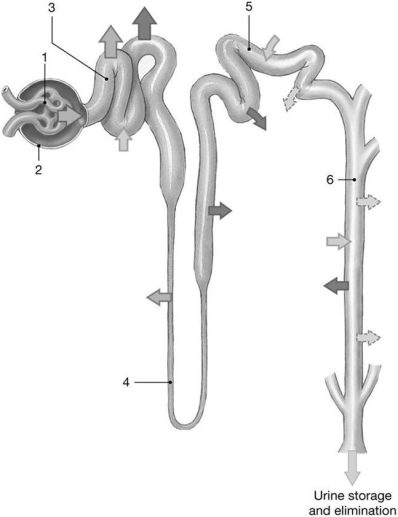A) nephron loop (loop of Henle)
B) distal convoluted tubule
C) papillary duct
D) renal corpuscle
E) ureter
G) None of the above
Correct Answer

verified
Correct Answer
verified
Multiple Choice
The outermost layer of the kidney is the
A) renal cortex.
B) renal medulla.
C) major calyx.
D) fibrous capsule.
E) renal pelvis.
G) C) and E)
Correct Answer

verified
Correct Answer
verified
Multiple Choice
Secretion of hydrogen ion by the PCT is by the process of
A) diffusion.
B) facilitated diffusion.
C) active transport.
D) cotransport.
E) countertransport.
G) None of the above
Correct Answer

verified
Correct Answer
verified
Multiple Choice
Reabsorbed water and solutes enter into the
A) afferent arteriole.
B) efferent arteriole.
C) peritubular fluid.
D) tubular fluid.
E) glomerulus.
G) A) and C)
Correct Answer

verified
Correct Answer
verified
Multiple Choice
Which of the following is a not a true statement regarding the countercurrent multiplication system?
A) The thin limb of the nephron loop is permeable to water.
B) The thick limb of the nephron loop is permeable to solutes.
C) Osmotic concentration in the nephron loop decreases as fluid flows toward the bottom of the loop.
D) Tubule fluid arrives at the DCT at about 100 mOsm/L.
E) The maximum solute concentration is about 1200 mOsm/L.
G) A) and C)
Correct Answer

verified
Correct Answer
verified
Multiple Choice
Insoluble deposits that form within the urinary tract from calcium salts, magnesium salts, or uric acidare called kidney stones or renal
A) calculi.
B) plaque.
C) caries.
D) otoliths.
E) lithotrophs.
G) A) and C)
Correct Answer

verified
Correct Answer
verified
Multiple Choice
Approximately ________ liters of glomerular filtrate enter glomerular capsules each day.
A) 480
B) 180
C) 125
D) 18
E) 1.8
G) B) and D)
Correct Answer

verified
Correct Answer
verified
Multiple Choice
Modified smooth muscle cells in the wall of the afferent arteriole that secrete renin are called
A) macula densa cells.
B) juxtaglomerular cells.
C) extraglomerular mesangial cells.
D) podocytes.
E) principal cells.
G) A) and E)
Correct Answer

verified
Correct Answer
verified
Multiple Choice
The final composition of urine is represented by which of the following statements?
A) Urine = substances reabsorbed + substances secreted.
B) Urine = substances filtered + substances reabsorbed + substances secreted.
C) Urine = substances secreted - substances reabsorbed - substances filtered.
D) Urine = substances filtered - substances reabsorbed + substances secreted.
E) Urine = substances reabsorbed - substances secreted - substances filtered.
G) A) and E)
Correct Answer

verified
Correct Answer
verified
Multiple Choice
The functional units of kidneys where blood is filtered and urine produced are called
A) pyramids.
B) nephrons.
C) calyces.
D) lobules.
E) lobes.
G) All of the above
Correct Answer

verified
Correct Answer
verified
Multiple Choice
________ is an inherited abnormality that affects the development and structure of kidney tubules.
A) Glomerulonephritis
B) Polycystic kidney disease
C) Nephrolithiasis
D) Renal failure
E) Hematuria
G) All of the above
Correct Answer

verified
Correct Answer
verified
Multiple Choice
Diuretics are used for all of the following reasons except
A) to reduce body weight.
B) to reduce water retention.
C) to reduce blood pressure.
D) to treat congestive heart failure.
E) to reduce glucose levels.
G) A) and B)
Correct Answer

verified
Correct Answer
verified
Multiple Choice
Capillaries that surround the proximal convoluted tubules are
A) proximal capillaries.
B) corticoradiate capillaries.
C) vasa recta capillaries.
D) efferent arterioles.
E) peritubular capillaries.
G) C) and E)
Correct Answer

verified
Correct Answer
verified
Multiple Choice
The prominent indentation on the medial surface of the kidney is the
A) calyx.
B) pelvis.
C) ureter.
D) hilum.
E) pyramid.
G) C) and D)
Correct Answer

verified
Correct Answer
verified
Multiple Choice
Damage to the glomerular filtration membrane allowing proteins into the capsular space would result in allof the following except
A) an increase in capsular colloid osmotic pressure.
B) a decrease in blood colloid osmotic pressure.
C) an increase in net filtration pressure.
D) an increase in GFR and fluid loss.
E) a decrease in capsular hydrostatic pressure.
G) B) and E)
Correct Answer

verified
Correct Answer
verified
Multiple Choice
The expanded beginning of the ureter connects to the
A) renal sinus.
B) renal pelvis.
C) renal calyx.
D) renal hilum.
E) renal corpuscle.
G) None of the above
Correct Answer

verified
Correct Answer
verified
Multiple Choice
Calculate filtration pressure (FP) in a nephron with a glomerular hydrostatic pressure of 55 mm Hg, a bloodcolloid osmotic pressure of 25 mm Hg, and a capsular hydrostatic pressure of 15 mm Hg.
A) FP = 10 mm Hg
B) FP = 95 mm Hg
C) FP = 55 mm Hg
D) FP = 45 mm Hg
E) FP = 15 mm Hg
G) D) and E)
Correct Answer

verified
Correct Answer
verified
Multiple Choice
The ________ test is often used to estimate the glomerular filtration rate.
A) inulin
B) glucose tolerance
C) CBC or complete blood count
D) specific gravity
E) creatinine clearance
G) A) and B)
Correct Answer

verified
Correct Answer
verified
Multiple Choice
Figure 26-2 The Nephron
 Use Figure 26-2 to answer the following questions:
-Which area(s) allow variable water reabsorption and is/are sensitive to the hormone ADH?
Use Figure 26-2 to answer the following questions:
-Which area(s) allow variable water reabsorption and is/are sensitive to the hormone ADH?
A) 1
B) 3
C) 4
D) 5 and 6
E) 3 and 6
G) A) and C)
Correct Answer

verified
Correct Answer
verified
Essay
List each organ of the urinary system and concisely describe its function.
Correct Answer

verified
Consisting of the kidneys, ureters, urin...View Answer
Show Answer
Correct Answer
verified
View Answer
Showing 61 - 80 of 137
Related Exams